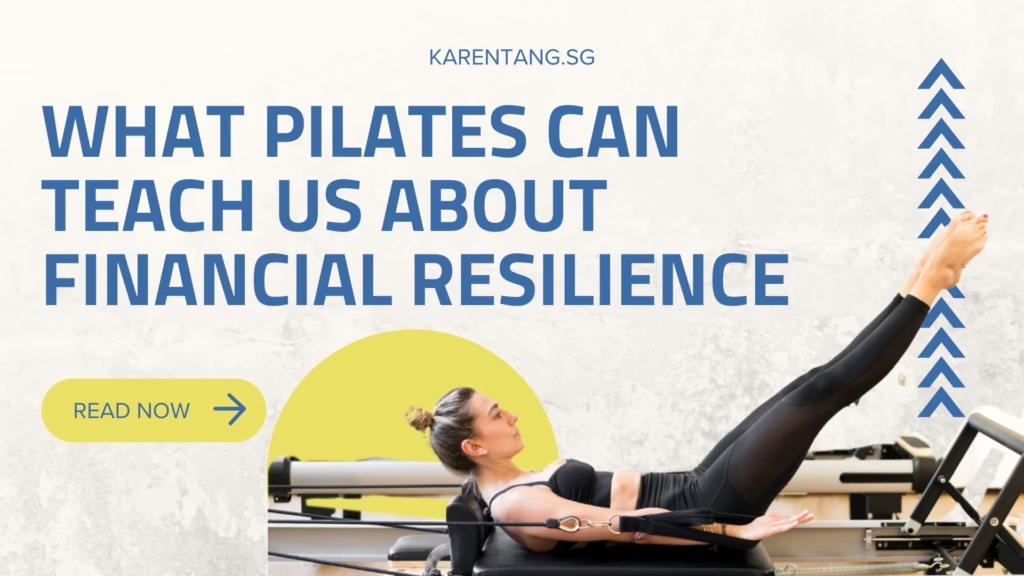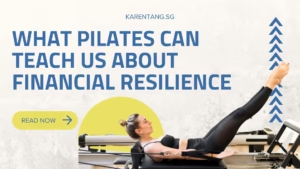Karen Tang, CFP®: Certified Financial Planner in Singapore
How Pilates Can Teach Us Financial Resilience

Twice a week, I show up at Focus Pilates reformer studio. I grip the straps, align my spine, engage my core, and push through controlled, precise movements. It’s not just about toned muscles or flexibility – it’s about resilience. Each session builds strength from the inside out, making me more balanced, more stable, and more capable of meeting life’s physical demands.
But here’s the thing: the lessons we learn on the reformer don’t have to stay on the mat. In fact, one of the most important connections I’ve made through Pilates is with an entirely different part of my life – my finances.
Let’s talk about financial resilience.
What Is Financial Resilience, Really?
Financial resilience is your ability to withstand, adapt to, and recover from financial shocks. It’s not about how much you earn or how “good” you are with money. It’s about being able to handle unexpected events – like a medical bill, job loss, a car repair – without spiraling into debt or anxiety.
Just like physical resilience doesn’t mean you never get sore or tired, financial resilience doesn’t mean you never hit a bump. It means you bounce back stronger, more stable, and with a clear plan forward.
Think about how we build strength in Pilates: slowly, consistently, and intentionally. We challenge our muscles with resistance, and in doing so, we train them to respond better under pressure. Financial resilience is built in the same way, not in giant leaps, but through small, disciplined steps repeated over time.
Pilates Principles Meet Financial Planning
There are five core principles in Pilates: centering, concentration, control, precision, and breath. And surprisingly, they translate beautifully into the financial world:
- Centering: Just like you focus on your core in Pilates, in personal finance, you focus on your financial core – your income, expenses, assets and liabilities. Know your numbers. Everything else builds from here.
- Concentration: Are you mindful about how you spend, save, and invest? Awareness brings clarity. Don’t just go through the motions. Know why you’re doing what you’re doing.
- Control: In Pilates, control is everything. Wild, flailing movements are ineffective and risky, just like reckless financial decisions. Budgeting and setting boundaries give you control over your money.
- Precision: Every dollar has a job. Just like your movement needs to be exact to activate the right muscles, your financial actions should be intentional whether it’s saving for an emergency or investing for the future.
- Breathe: Sometimes, the best thing you can do when things get tough, in Pilates or life, is to pause and breathe. Financial stress is real, and managing your emotional response is a vital part of resilience.
As Morgan Housel, author of The Psychology of Money, says:
“The ability to do what you want, when you want, with who you want, for as long as you want, has an unmeasurable value.”
That’s what financial resilience gives you – freedom and flexibility.
Building Your Financial Core
So how do you start? Just like your first Pilates class, it’s not about perfection – it’s about commitment.
- Create an Emergency Fund
Aim for at least 3 to 6 months of essential expenses. This is your financial reformer – your base that keeps you steady when things shift unexpectedly. - Track Your Spending
Awareness is half the battle. Use a simple spreadsheet or an app. Know where your money goes and where it should go. - Pay Down High-Interest Debt
Just like tight hip flexors limit your movement, debt limits your financial flexibility. Start tackling it strategically. - Invest in Your Future
Whether it’s a retirement account or a small investment in yourself (education, skills), start planting seeds. Financial resilience isn’t just about surviving, it’s about thriving. - Stay Consistent
Twice a week on the reformer? It fits my schedule perfectly. It is about staying consistent. How about applying a regular rhythm to your money habits? Automatic savings, monthly check-ins – steady progress beats sporadic effort.
And as a financial coach, I will say this:
“The journey to your financial wellbeing is not a sprint. It’s a marathon that requires consistency, discipline, and a long-term mindset.”
Resilience Is a Lifestyle
Pilates has taught me to show up, to be patient with progress, and to appreciate the quiet strength that comes from consistency. Financial resilience is no different. It doesn’t happen overnight. But it gives you the confidence to move through life, and through the unexpected, with control and calm.
So here’s your call to action:
Just start. Choose one small thing you can do this week to strengthen your financial core. Maybe it’s setting up a savings transfer, reviewing your expenses, or scheduling time to check your balance sheet. Just like Pilates, every small move counts and over time, they add up to something powerful.
If you’re ready to strengthen your financial core but aren’t sure where to start, do reach out at https://karentang.sg/consultation. I’m here to help guide you with the support and clarity you need.
Your body is getting stronger. Now let your finances catch up!
CATEGORIES
KAREN'S LATEST BLOGS
Latest Blog Posts

An LPA Isn’t Just Paperwork, It’s Protection for Your Family
https://youtu.be/1-e5qY8ErCk Most of us think of writing a will to decide what happens after we’re gone. But what about ensuring your affairs are taken care

How Pilates Can Teach Us Financial Resilience
https://youtu.be/BBNtQbtdhqs Twice a week, I show up at Focus Pilates reformer studio. I grip the straps, align my spine, engage my core, and push through

Financial Coaching: Why It’s Becoming Essential in Singapore
https://youtu.be/ZZzyWeYiZHQ Let’s face it – living in Singapore is expensive. Between the rising costs of housing, daily living, and societal pressures to “make it,” it’s
